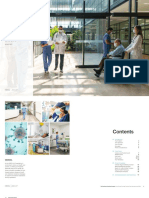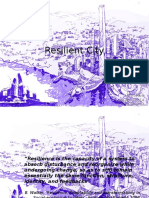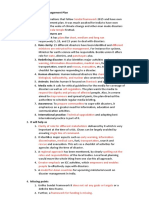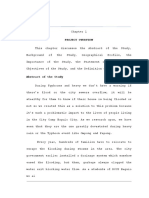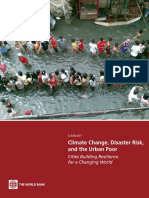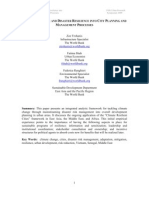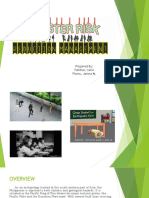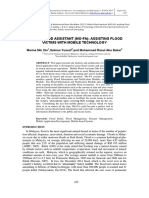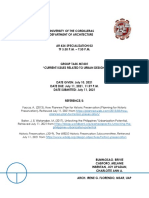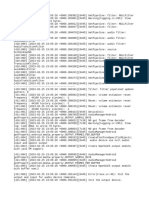Making Cities Resilient: My City Is Getting Ready!
Making Cities Resilient: My City Is Getting Ready!
Uploaded by
Melanie CabforoCopyright:
Available Formats
Making Cities Resilient: My City Is Getting Ready!
Making Cities Resilient: My City Is Getting Ready!
Uploaded by
Melanie CabforoOriginal Title
Copyright
Available Formats
Share this document
Did you find this document useful?
Is this content inappropriate?
Copyright:
Available Formats
Making Cities Resilient: My City Is Getting Ready!
Making Cities Resilient: My City Is Getting Ready!
Uploaded by
Melanie CabforoCopyright:
Available Formats
www.unisdr.
org/campaign
Making Cities Resilient: My City is Getting Ready!
World Disaster Reduction Campaign 2010-2011
Makati City is getting ready!
Makati City, National Capital Region (Metro-Manila), Philippines
Population: 510,383
Type of Hazard(s): Typhoons, Earthquakes,
Floods
For the past years, Makati is among the cities
in NCR affected by several
hydrometeorological disasters such as
Typhoon Milenyo (Xangsane) in 2006,
Typhoon Egay (Sepat) in 2007, Typhoon
Ondoy (Ketsana) in 2009, and Typhoon
Pepeng (Parma) also in 2009.
There are two physical characteristics of the City that pose danger to its present and future
development. A part of the Valley Fault System, a potential generator of a large magnitude
of earthquake in NCR is located at the eastern part of Makati. Six (6) barangays
(communities) were identified as high risk areas. Second, the western portion of the City is
composed of former tidal flats where seven (7) barangays are flood-prone.
Disaster Risk Reduction activities
Essential 1: Put in place Organisation and coordination
The City Government established and institutionalised the Makati City Disaster
Coordinating Council (MCDCC) as a specialised task group for the coordination of disaster
reduction policies and strategies between the national, regional levels and the city level.
MCDCC also serves as a policy decision-making body for DRR-related activities.
Essential 2: Assign a budget for DRR
As mandated by the Local Government Code of 1991 (RA 7160) the City Government
allots 5% of its total annual fund for calamity. From 2010 onwards, the City Government
optimises the said fund to be used for disaster preparedness and risk reduction in addition
to disaster response and post recovery initiatives.
2
Essential 4: Invest in and maintain critical infrastructure that reduces risks
Land improvement projects such as concreting of roads and drainage improvement are
100% completed. Relatively, regular maintenance and improvements of roads including
clearing of sagging and entangled telecommunication cables in major roads as well as
regular cleaning of the drainage system through dredging and de-clogging are being
undertaken by the City’s Department of Engineering and Public Works in collaboration with
the Department of Environmental Services and the barangays (communities). Schools,
hospitals, flood control facilities and other critical infrastructure are also assessed in terms
of safety and efficiency.
Essential 6: Apply and enforce realistic, risk-compliant building regulations and land use
planning principles
As part of its mandates, the Department of Engineering and Public Works (DEPW) through
its Office of Building Official (OBO) conducts annual inspections of buildings and facilities
within the City to ensure strict compliance with the National Building Code. The Zoning
Division of the Urban Development Department (UDD), on the other hand, handles the
implementation of the Comprehensive Land Use Plan (CLUP) and Zoning Ordinance to
ensure compliance of new and existing establishments before issuance of new clearances.
Essential 7: Educational programmes and training on DRR are in place in schools and
local communities
Climate change and disaster risk reduction have been integrated in the school curricula at
the elementary and secondary levels. Intensive awareness drive on disaster risk reduction
and preparedness were also being undertaken at the community level especially for those
who are staying at home and out-of-school youth through various IEC (Information
Education Campaign) activities using existing media such as television, radio,
newspapers, and brochures.
“We in Makati have long been taking steps towards disaster risk reduction.
We know that advance planning and preparation is the best way to
minimize, if not totally eliminate, the impact of disaster on members of our
communities, our properties and our economies. We realize that our ability
to mitigate the effects of disasters on our City will impact positively not only
on the safety of both our resident community and our private sector, but on
the national economy as well.”
- Makati Mayor Jejomar Erwin S. Binay, Jr.
World Disaster Reduction Campaign 2010-2011
Making Cities Resilient: My City is Getting Ready!
www.unisdr.org/campaign
isdr-campaign@un.org
You might also like
- The Adams Resiliency Plan For NYCDocument10 pagesThe Adams Resiliency Plan For NYCEric Adams 2021100% (1)
- (Original For Recipient) : Sl. No Description Unit Price Discount Qty Net Amount Tax Rate Tax Type Tax Amount Total AmountDocument1 page(Original For Recipient) : Sl. No Description Unit Price Discount Qty Net Amount Tax Rate Tax Type Tax Amount Total Amount50. Atharva Patel100% (1)
- MDRRMP Contingency Plan CY 2017-2021Document77 pagesMDRRMP Contingency Plan CY 2017-2021Don Vincent Bautista Busto89% (9)
- Mmda 1 - Briefing On Disaster Preparedness Program - Usec JimenezDocument45 pagesMmda 1 - Briefing On Disaster Preparedness Program - Usec JimenezCyrus MontalanNo ratings yet
- Pandemic Resilient HospitalDocument17 pagesPandemic Resilient HospitalMelanie Cabforo100% (1)
- Moving Average GuideDocument16 pagesMoving Average Guidesuisuifx538795% (66)
- Urban Risks in Disaster ManagementDocument4 pagesUrban Risks in Disaster ManagementM.E.RezaNo ratings yet
- Making Megacites Safer From Earthquake Impacts A Shared Vision For Metro Manila and Makati City in The PhilippinesDocument8 pagesMaking Megacites Safer From Earthquake Impacts A Shared Vision For Metro Manila and Makati City in The PhilippinesjulsNo ratings yet
- Resilient CityDocument41 pagesResilient Citywitanti nur utami100% (1)
- Disaster Mitigation in The Kemiri River Watershed Area Sentani District Jayapura Regency - VnvopgmoovDocument23 pagesDisaster Mitigation in The Kemiri River Watershed Area Sentani District Jayapura Regency - Vnvopgmoovjuliansyah.harahapNo ratings yet
- Urban and Disaster Risk Management Responses To COVID-19Document16 pagesUrban and Disaster Risk Management Responses To COVID-19Helmer Edgardo Monroy GonzálezNo ratings yet
- Shaw - Metro Manila Case StudyDocument8 pagesShaw - Metro Manila Case StudyMaharLagmayNo ratings yet
- Script LodsDocument8 pagesScript LodsShirasagi HimegimeNo ratings yet
- Asian Megacities Threatened by Climate ChangeDocument2 pagesAsian Megacities Threatened by Climate ChangeThuỳ TrangNo ratings yet
- Voluntarism and Disaster Risk ReductionDocument14 pagesVoluntarism and Disaster Risk ReductionCDMP BangladeshNo ratings yet
- DisasterDocument5 pagesDisasterYKIT CentreNo ratings yet
- Cities Disaster LivelihoodDocument11 pagesCities Disaster LivelihoodapperdapperNo ratings yet
- National Disaster Management PlanDocument16 pagesNational Disaster Management PlanKashifNo ratings yet
- Making Cities Resilient 2030Document3 pagesMaking Cities Resilient 2030kuya.intian01No ratings yet
- Module-2 Ice Besck204aDocument16 pagesModule-2 Ice Besck204amp.chinnusNo ratings yet
- Staying Afloat Operating Tourism in Disaster-Prone PDFDocument9 pagesStaying Afloat Operating Tourism in Disaster-Prone PDFrgo.figueroaNo ratings yet
- 650 EMImainstreaming PDFDocument106 pages650 EMImainstreaming PDFWilvic Jan GacitaNo ratings yet
- Chapter1 FinalDocument21 pagesChapter1 FinalGelo MoralNo ratings yet
- World Cities 2021 - Concept NoteDocument4 pagesWorld Cities 2021 - Concept NoteÂngelo AlvesNo ratings yet
- EMERGENCY AND DISASTER RISK RESPONSE IN COTABATO CITY - Doc Statement of ProblemDocument4 pagesEMERGENCY AND DISASTER RISK RESPONSE IN COTABATO CITY - Doc Statement of Problemmary claire candidoNo ratings yet
- 230 TenEssentialsBonn MAKATIDocument61 pages230 TenEssentialsBonn MAKATIkaateviNo ratings yet
- ADB Tor Resilience Plan PDFDocument13 pagesADB Tor Resilience Plan PDFAGNo ratings yet
- Chennai Disaster ManagementDocument4 pagesChennai Disaster ManagementMuthu KumaarrNo ratings yet
- 09 - Chapter 5 Philippines.Document17 pages09 - Chapter 5 Philippines.Dahlia AlmedaNo ratings yet
- CDRA MongkayoDocument513 pagesCDRA MongkayoQueenbee FacinalNo ratings yet
- Preparing Metro Manila Toward Urban Resiliency Prospects and RetrospectDocument20 pagesPreparing Metro Manila Toward Urban Resiliency Prospects and RetrospectAndrea ArellanoNo ratings yet
- An Earthquake Risk Management Master PlanDocument9 pagesAn Earthquake Risk Management Master PlanSGNo ratings yet
- Radiografía Urbana6Document46 pagesRadiografía Urbana6Mauricio RuizNo ratings yet
- Espina Finalized 1Document33 pagesEspina Finalized 1Rosalyn ColisaoNo ratings yet
- Disaster Risk Urban Poor FinalDocument33 pagesDisaster Risk Urban Poor Finalsoren sorentoNo ratings yet
- Module 3 in NSTP DRRMDocument25 pagesModule 3 in NSTP DRRMAira PascuaNo ratings yet
- Example of Thesis Chapter 1 - 3Document30 pagesExample of Thesis Chapter 1 - 3kenNo ratings yet
- The Importance of Architecture Education For Disaster MitigationDocument12 pagesThe Importance of Architecture Education For Disaster MitigationmiasoejosoNo ratings yet
- Formative Assessment 5Document2 pagesFormative Assessment 5Jay TulodNo ratings yet
- A Md. Zamri EarthquakeDocument5 pagesA Md. Zamri EarthquakeChang BongNo ratings yet
- Inbound 5359606905794921314Document24 pagesInbound 5359606905794921314leimhar2004No ratings yet
- 03 +iv+alexander+025-035Document12 pages03 +iv+alexander+025-035Neile JardenicoNo ratings yet
- ICT in Disaster Management in BangladeshDocument70 pagesICT in Disaster Management in BangladeshAntonio Rogers100% (1)
- The Role of Technology in Building A Resilient CitDocument5 pagesThe Role of Technology in Building A Resilient CitRini LestariNo ratings yet
- Preparing Metro Manila Toward Urban Resiliency Prospects and RetrospectsDocument19 pagesPreparing Metro Manila Toward Urban Resiliency Prospects and RetrospectsWilvic Jan GacitaNo ratings yet
- buildingclimateandENDocument17 pagesbuildingclimateandENRipan DebnathNo ratings yet
- DIA ENE182 Group 4 Valencia City PDFDocument10 pagesDIA ENE182 Group 4 Valencia City PDFAlonzo Gabriel LimoconNo ratings yet
- Editorial: Why Is Community Action Needed For Disaster Risk Reduction and Climate Change Adaptation?Document11 pagesEditorial: Why Is Community Action Needed For Disaster Risk Reduction and Climate Change Adaptation?diana patricia carvajal riveraNo ratings yet
- Mini-Research DraftDocument5 pagesMini-Research DraftBOGART JRSENIORNo ratings yet
- UNDRR Disaster Resilience Scorecard For Cities Preliminary English Accessible May2024Document84 pagesUNDRR Disaster Resilience Scorecard For Cities Preliminary English Accessible May2024SulistyawanNo ratings yet
- Disaster Risk Reduction ManagementDocument17 pagesDisaster Risk Reduction ManagementCarlo Fabillar100% (2)
- Conference Paper Mobile Flood AlertDocument8 pagesConference Paper Mobile Flood AlertMuhammad RasulNo ratings yet
- Flood Disaster Risk ReductioDocument18 pagesFlood Disaster Risk ReductioJeremiah Miko LepasanaNo ratings yet
- ReportDocument96 pagesReportActionNewsJaxNo ratings yet
- 1 s2.0 S2212420921003654 MainDocument12 pages1 s2.0 S2212420921003654 MainMax VasquezNo ratings yet
- Republic Act No. 10121 - Official Gazette of The Republic of The PhilippinesDocument25 pagesRepublic Act No. 10121 - Official Gazette of The Republic of The PhilippinesYasmin HattaNo ratings yet
- Exposing Vulnerabilities: Monsoon Floods in Mumbai, India: Stacey Stecko and Nicole BarberDocument14 pagesExposing Vulnerabilities: Monsoon Floods in Mumbai, India: Stacey Stecko and Nicole Barberpravin pawarNo ratings yet
- ToR Maputo Programme Assistant For DRR ER PDFDocument3 pagesToR Maputo Programme Assistant For DRR ER PDFMauro Domingo'sNo ratings yet
- Disaster Risk Reduction and Management Plan of Selected Public Schools in Marikina CityDocument20 pagesDisaster Risk Reduction and Management Plan of Selected Public Schools in Marikina CityAbigailNo ratings yet
- Monsoon Book 2021 07 06 202Document135 pagesMonsoon Book 2021 07 06 202Sandip DeyNo ratings yet
- ToR Environmental and Social Management System (ESMS)Document54 pagesToR Environmental and Social Management System (ESMS)Eko CharkoNo ratings yet
- Policy Note - Understanding Risk in an Evolving WorldFrom EverandPolicy Note - Understanding Risk in an Evolving WorldNo ratings yet
- Questions Concerning The Implementing Rules and Regulations of PD 957 and BP 220Document17 pagesQuestions Concerning The Implementing Rules and Regulations of PD 957 and BP 220Melanie CabforoNo ratings yet
- 2.0 HUDCC ProfileDocument6 pages2.0 HUDCC ProfileMelanie CabforoNo ratings yet
- History: Pier Luigi Nervi Eduardo Tarroja Félix CandelaDocument17 pagesHistory: Pier Luigi Nervi Eduardo Tarroja Félix CandelaMelanie CabforoNo ratings yet
- Clasification of HospitalDocument3 pagesClasification of HospitalMelanie CabforoNo ratings yet
- How Tiny and Homey Is A Small House in The Philippines - Architects ExchangeDocument4 pagesHow Tiny and Homey Is A Small House in The Philippines - Architects ExchangeMelanie CabforoNo ratings yet
- Ain Shams Engineering Journal: Ahmed S. Abd Elrahman, Moureen AsaadDocument11 pagesAin Shams Engineering Journal: Ahmed S. Abd Elrahman, Moureen AsaadMelanie CabforoNo ratings yet
- Who Owns Our Cities - and Why This Urban Takeover Should Concern Us All - Cities - The GuardianDocument12 pagesWho Owns Our Cities - and Why This Urban Takeover Should Concern Us All - Cities - The GuardianMelanie CabforoNo ratings yet
- Guidelines For Slope Management in Subdivisions: Cardinia Shire Council - Pakenham East Precinct Structure PlanDocument18 pagesGuidelines For Slope Management in Subdivisions: Cardinia Shire Council - Pakenham East Precinct Structure PlanMelanie CabforoNo ratings yet
- Planners-Plan-For-Historic-Preservation/ Philippines-Urbanization-PotentialDocument14 pagesPlanners-Plan-For-Historic-Preservation/ Philippines-Urbanization-PotentialMelanie CabforoNo ratings yet
- Advice From An Architect - 10 Tips To Create A Cooler HomeDocument12 pagesAdvice From An Architect - 10 Tips To Create A Cooler HomeMelanie CabforoNo ratings yet
- Building 101 - 25 Tips For A Tropical HomeDocument11 pagesBuilding 101 - 25 Tips For A Tropical HomeMelanie CabforoNo ratings yet
- Myasthenia GravisDocument3 pagesMyasthenia GravisfsNo ratings yet
- PanelDocument32 pagesPanelkishore_bulli6666No ratings yet
- "CUSTOMER PREFERENCE OF ATMsDocument59 pages"CUSTOMER PREFERENCE OF ATMskeremaneviNo ratings yet
- Delimitation Commission KarnatakaDocument70 pagesDelimitation Commission KarnatakaDEEPAKNo ratings yet
- Tax II Outline 2012 MonteroDocument11 pagesTax II Outline 2012 MonteroTerence GuzmanNo ratings yet
- CPE - Stage 5 - AcknowledgementsDocument1 pageCPE - Stage 5 - AcknowledgementshotanNo ratings yet
- Virtual Gym Management System: Manjiri R. Girnale Komal D. UntwalDocument6 pagesVirtual Gym Management System: Manjiri R. Girnale Komal D. UntwalRHEALYN JOY BALDERAMANo ratings yet
- Sample Test Year 1Document5 pagesSample Test Year 1Nhung NguyenNo ratings yet
- Digestive System of A FrogDocument14 pagesDigestive System of A FrogLoida Gigi AbanadorNo ratings yet
- Kuman Business Meeting by SlidesgoDocument45 pagesKuman Business Meeting by SlidesgoAndrei NaumovNo ratings yet
- Bill 3Document1 pageBill 3Yogesh GhogaleNo ratings yet
- Use of Tows and Planning MatricesDocument4 pagesUse of Tows and Planning Matricesmarichu apiladoNo ratings yet
- Thesis Topics For Masters in Environmental ArchitectureDocument6 pagesThesis Topics For Masters in Environmental Architecturesandraacirbalpaterson100% (2)
- TDG 0018, 0019 & 0020 Rev - 0Document10 pagesTDG 0018, 0019 & 0020 Rev - 0Preeti goswamiNo ratings yet
- TraceDocument97 pagesTraceAlissandro AquinoNo ratings yet
- Equipment Maintenance Step 1 2 3 - ACT - TRG - 053Document74 pagesEquipment Maintenance Step 1 2 3 - ACT - TRG - 053occhityaNo ratings yet
- Smartsense Campus Hiring Coding TaskDocument3 pagesSmartsense Campus Hiring Coding TaskRaj PrajapatiNo ratings yet
- D e Thi THPT 1Document19 pagesD e Thi THPT 1Lê Thị Linh ChiNo ratings yet
- AC1 SanAugustineDeHippo TanDocument5 pagesAC1 SanAugustineDeHippo TanRaymond Gregg TanNo ratings yet
- Research IntroductionDocument19 pagesResearch IntroductionRicaNo ratings yet
- Tendernotice 1Document2 pagesTendernotice 1AM SureshNo ratings yet
- Asian PaintsDocument35 pagesAsian PaintsAishNo ratings yet
- Updated Management of Malar Edema Mounds and FestoDocument13 pagesUpdated Management of Malar Edema Mounds and FestoErik BrooksNo ratings yet
- Fisheries Quiz Bee 2024Document2 pagesFisheries Quiz Bee 2024Neil Virgille SaldoNo ratings yet
- Step by Step Oracle Installation Guides Kamran AgayevDocument201 pagesStep by Step Oracle Installation Guides Kamran AgayevSayed NabilNo ratings yet
- Cinematography Basics: I Year (Integrated)Document12 pagesCinematography Basics: I Year (Integrated)raviitherising0% (1)
- 2019 International OER GuideDocument11 pages2019 International OER Guideforplaystore087No ratings yet
- Using Dialogue in Teaching GrammarDocument2 pagesUsing Dialogue in Teaching GrammarLailyNo ratings yet




